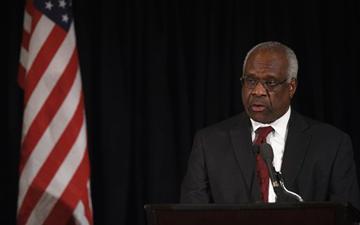
A quiet justice speaks
(AP Photo/Susan Walsh, Pool)
Monday, Leap Day, was a big day for Clarence Thomas. After a decade of silence, he posed a question during Supreme Court hearings. Some are suggesting it is his concern for the 2nd amendment that prompted his comment. Perhaps. Only he knows and given his traditional reticence, I’m not expecting him to explain his motives to the rest of us. He, of course, was there for the controversy that surrounded his appointment. Given the tangling of racism and sexism his nomination presented the country perhaps all that can be said now, some 25 years later, is that some previously taboo subjects were put on the table for dialogue.
I have written before and experienced myself that one of the greatest tasks people in leadership roles must grapple with are the time when the right thing to do is nothing. No comment, no question, no explanation. A similar act is to step aside, stand down, or resign. Justice Thomas, having forgone the latter option when his nomination was challenged, has pursed the former discipline. He comments only when absolutely necessary and apparently, it has not been absolutely necessary for him to comment in the past decade. Perhaps he has been more than willing to let Justice Scalia and other conservative justices take the lead. But given Justice Scalia’s absence, Justice Thomas appears to be working from a place of discernment—“what is needed of me now?” and acting based upon this reflection.
After a decade of listening, he asked one powerfully phrased question that both made a point and highlighted a standard not yet brought forward in the case before the court. Asking a question after ten years of not asking any makes an impact.
Also on Monday, in a separate case, Justice Thomas weighed in supporting the U.S. Supreme Court’s decision to let stand a California court ruling upholding inclusionary zoning requirements in new housing developments. By choosing not to hear the case, San Jose’s Affordable Housing law stands. San Jose’s mayor, Sam Liccardo, expressed happiness that the city can now implement inclusionary zoning citywide.
Here, Justice Thomas gave some window into his mixed feelings about the law. The particulars of this case didn’t seem like a good one to try, even though Justice Thomas had this to say about the practice of requiring builders to include 15 percent of new residential units for sale below market rates, “Until we decide this issue, property owners and local governments are left uncertain about what legal standard governs legislative ordinances and whether cities can legislatively impose exactions that would not pass muster if done administratively.” Even holding these doubts, he recommended that the high court not take the case.
I was not in favor of his nomination to the court and typically disagree with his conservative stance on issues. But his leadership stance offers examples we can all learn from: patience, respectful attention and concern for asking the best questions rather than striving to have all the answers.
